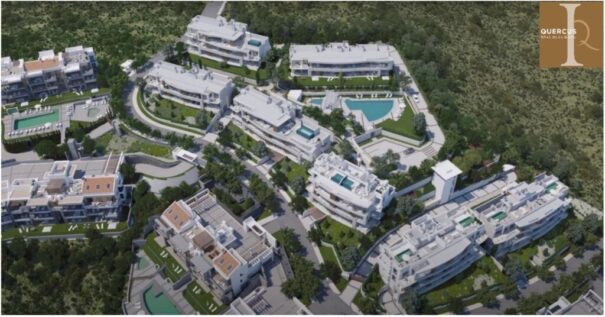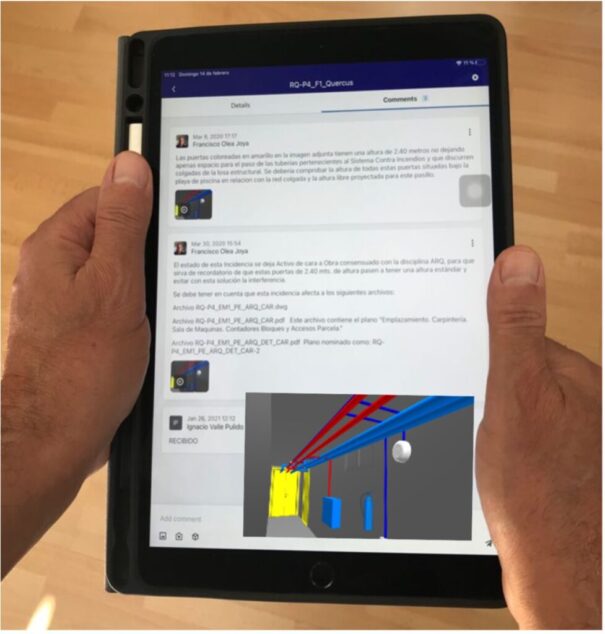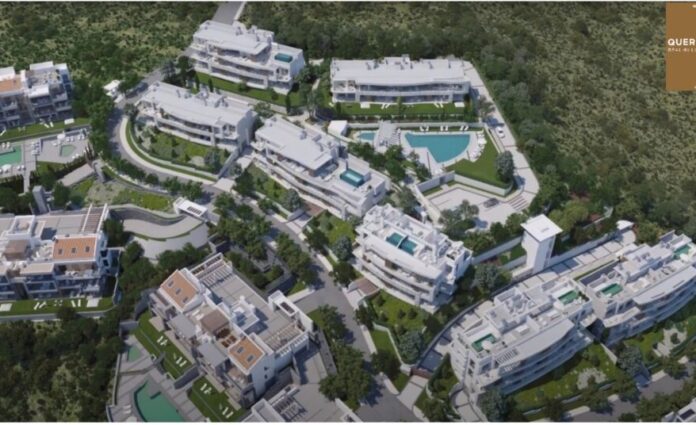Project Brief:
The Quercus Residential Complex is part of the development of the Real de la Quinta Partial Plan, belonging to the municipality of Benahavis in the province of Malaga. The Plan consists of several residential complexes around a golf course and an artificial lake where the Lake-Club and its adjacent sports-recreational activities areas are located. Located in an exceptional natural landscape, it enjoys panoramic views over the Mediterranean Sea.
Quercus consists of 102 apartments with large terraces, distributed in 18 terraced hillside blocks, with a maximum height of 3 floors and no more than 2 apartments per level. The common space free of buildings has been organized in landscaped areas, pedestrian circulation areas adapted to the topography of the terrain and swimming pool areas for adults and children.

Aerial view of the Quercus Residential Complex
Implementation of the BIM methodology in the project
Grupo Inmobiliario La Quinta, with 30 years of experience in the real estate market, is the developer of this macro project. In its aim to create high-quality innovative products and services, it decided to use technological methods and means in line with its business objectives for the development of these residential complexes. Hence its commitment to the implementation of the BIM methodology in its projects.
The implementation has been carried out gradually and progressively. The BIM Technical Management of the La Quinta Group, under the responsibility of the consultants O&B arquitectos, prepared a phased plan taking into account:
- The lack of national regulations on BIM methodology.
- The level of knowledge of the agents involved in the process.
- The traditional reluctance to change already acquired professional habits.
- The setting of achievable Objectives, for each of the stages.
- The acquisition of a progressive BIM Maturity Level, as homogeneous as possible, in all the teams participating in the project.
Pilot Plan: Olivos Residential Complex.
We started with a Pilot Plan for the Olivos Residential Complex. For this complex, the architectural firm González & Jacobson had already drafted a Basic Project for which a Municipal Building Permit had been requested and was preparing the Execution Project. As it is obvious, the elaboration of the Models was based on the plans of the Project.
The BIM D.T. planned the structure of the Models to be elaborated, drafted a BIM Execution Plan that included the Client’s Information Requirements (EIR), and elaborated some BIM standards or norms for the La Quinta Group.
This Pilot Plan was published by the magazine buildingSMART.Spain on February 5, 2019, in its section: Successful Cases.
Recently on November 12, 2020, has achieved the Provisional Certification of Sustainable Construction BREEAM.ES Housing with the Classification: Very Good.

BREEAM Certification of the Quercus Residential Complex
The choice of openBIM standards in the project
The project drafted for this residential complex was also carried out by the architectural firm Gonzalez & Jacobson, but this time in collaboration with the engineering firms CQD and MontEStudio.
The next step with respect to OLIVOS, in terms of the implementation of the methodology, consisted of:
- Plans were generated from the Models. Consistency between plans and models was ensured, in terms of information. If something changed in the Model during the Design Phase, it automatically changed in the Plans.
- The decision to work “only” with openBIM standards, to allow each discipline to choose the modeling software.
- Specific workflows were established for the Design and Construction Phases, allowing to obtain “As-Built” models according to the business objectives for the Operation and Maintenance Phase.
The software used for modeling by the Architecture and Structure disciplines has been Revit. The latter also used CypeCad for the calculation. The MEP discipline used TeKton3D for both calculation and modeling.
The model delivery format for all disciplines was the IFC standard. For interdisciplinary coordination and quality control of the models, we used the BCF standard. The result in terms of interdisciplinary collaboration has been very satisfactory, as we have been able to verify by asking all the teams involved in the process about this particular point.
Usage of Catenda Hub during the Construction Phase
Since Pilot Plan, we have had a collaborative platform in the cloud that works as a general repository of all the documentation that is being generated and that allows us to view multiple file-formats, both 2D and 3D.
For the Construction Phase, the BIM D.T. advised the Property to incorporate the Catenda Hub (previously Bimsync) platform into the CDE for the following reasons:
- It is intended to work exclusively with openBIM standards.
- The user interface is well structured, intuitive, and very easy to use.
- It allows us to archive models, federate them at our convenience, save this federation through the Bookmarks command, and share it with the rest of the users.
- It allows an efficient search of issues and drawings through a simple system of multiple tags.

Issue filters with tags in Catenda Hub (previously Bimsync)
- It allows linking non-graphical information to the BIM objects of the modeling through two types of Libraries:
- Generic Libraries: which allow links to your Classification Systems.
- Document Libraries: which allow you to link documents previously archived in Catenda Hub (previously Bimsync) or stored in Libraries created through links to external platforms such as Sharepoint or Dropbox. There is also an option that allows us to manage links to websites through links.
- It allows you to link to an Issue, files located in the Libraries of the Platform, or located on your computer.
- It has an App for mobile devices, which is Catenda Site that allows you to consult the plans and models on site, take photos and create incidents on site.

Usage of Catenda Site on the tablet
Regardless of all the above, it has common options with other collaborative platforms in the market, such as:
- View or download previous versions of models and drawings.
- Viewing and exporting parametric information of BIM objects to Excel sheets.
- Enabling a workflow through the Issues tool to help identify and communicate concerns or improvements to all project documentation, using BCF files.
Results expected
Each project has a different casuistry. In our case, in addition to proposing clear and achievable objectives that would generate satisfaction at the end of each phase, it was essential to select effective tools that would facilitate the transition through all stages of the project with favorable results.
We believe that the selection of Catenda Hub (previously Bimsync) for the Quercus project has been the right choice since it is enriching and facilitating the collaborative work in the construction phase, while at the same time generating a series of expectations for the future.
The work teams have been able to integrate quickly into the workflow created for the platform, after a concise training by the BIM D.T.
We are currently working with IFC 2×3 CV 2.0 and IFC 4 RV 1.1 files.
Our expectations are set on the correct export of the federated models at the end of the Construction Phase, where the BIM Objects will be linked to files collected during this phase and stored in external Libraries.
We have confidence in Catenda Hub’s technical support and their effort to constantly improve the applications and functionality of this platform.

